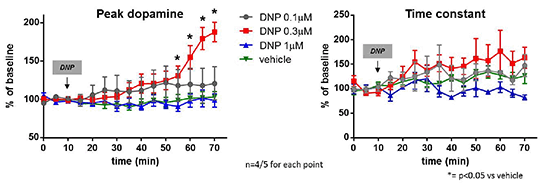Potential Psychoactive Effects of 2,4-Dinitrophenol (DNP) 2,4-Dinitrophenol (DNP) is a synthetic chemical that uncouples mitochondrial respiration. Although it is not licensed, it is currently used as a weight-loss agent. Recent UK reports highlight an increased frequency of severe clinical toxicity caused by exposure to DNP (1). Although 2 DNP-related deaths have been included in the National Programme on Substance Abuse Deaths' report, controversies exist about its classification as a “legal high”, as no psychoactive effects have been described for this compound (2). The aim of this study was to investigate the possible psychoactive actions of DNP, by evaluating its effects on electrically-evoked dopamine (DA) efflux from rat nucleus accumbens, a brain region involved in drug reinforcement and addiction. Brain slices (0.4mm thick) obtained from 8 weeks old male Wistar rats were kept in oxygenated artificial cerebro-spinal fluid (aCSF) and superfused with ethanol (vehicle) or DNP at 0.1, 0.3 and 1 μM. DA efflux was evoked by a stimulus train of 10 × 1 ms pulses 10 ms apart (100 Hz), and measured by fast cyclic voltammetry. Two parameters were measured: 1) peak DA efflux and 2) the time-constant of the reuptake half-life. Values are expressed as mean ± S.E.M.; statistical analysis was performed using 2-way ANOVA.
Superfusion of brain slices with 0.3 μM DNP gradually increased DA peak in the nucleus accumbens shell, reaching a peak effect about 60 min after drug incubation (188 ± 14% of baseline DA release); by contrast, superfusion of 0.1 or 1 μM DNP did not significantly affect DA peak. DNP had no significant effect on DA reuptake. DNP is able to increase peak DA efflux in the accumbens shell, apparently via a mechanism distinct from slowing down DA reuptake. We are thus testing the potential effects of DNP at the DA transporter in ligand binding studies with the specific DAT ligand [125I]RTI121. These data will be presented at the meeting. These voltammetry data, by demonstrating DA potentiating effects of DNP, highlight the potential addictive risk of this drug. 1. Kamour A et al (2014) Emerg Med J. (in press) pii: emermed-2013-203335 2. King and Nutt DJ. (2014). Lancet 383:952
|


